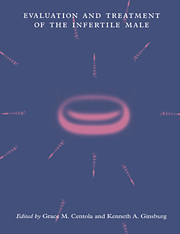Book contents
- Frontmatter
- Contents
- Preface
- List of contributors
- 1 Andrology
- 2 Sperm–egg interaction
- 3 Routine semen analysis
- 4 Computer-aided sperm analysis: a critical review
- 5 Antisperm antibodies: diagnosis and treatment
- 6 The sperm penetration assay
- 7 Intrauterine insemination for male factor
- 8 Processing human semen for insemination: comparison of methods
- 9 New assays for evaluating sperm function
- 10 Assisted reproductive technology for male factor infertility
- 11 Microinjection techniques for male infertility
- 12 Therapeutic donor insemination: screening, indications and technique
- 13 Endocrine assessment and hormone treatment of the infertile male
- 14 The urologic evaluation of the infertile male
- 15 Azoospermia: the diagnosis and treatment
- 16 White blood cells in semen and their impact on fertility
- 17 Psychological aspects of male infertility: lifting the shroud of shame
- 18 Evaluation of the female partner
- Index
16 - White blood cells in semen and their impact on fertility
Published online by Cambridge University Press: 16 September 2009
- Frontmatter
- Contents
- Preface
- List of contributors
- 1 Andrology
- 2 Sperm–egg interaction
- 3 Routine semen analysis
- 4 Computer-aided sperm analysis: a critical review
- 5 Antisperm antibodies: diagnosis and treatment
- 6 The sperm penetration assay
- 7 Intrauterine insemination for male factor
- 8 Processing human semen for insemination: comparison of methods
- 9 New assays for evaluating sperm function
- 10 Assisted reproductive technology for male factor infertility
- 11 Microinjection techniques for male infertility
- 12 Therapeutic donor insemination: screening, indications and technique
- 13 Endocrine assessment and hormone treatment of the infertile male
- 14 The urologic evaluation of the infertile male
- 15 Azoospermia: the diagnosis and treatment
- 16 White blood cells in semen and their impact on fertility
- 17 Psychological aspects of male infertility: lifting the shroud of shame
- 18 Evaluation of the female partner
- Index
Summary
Definition and prevalence of leukocytospermia
Leukocytospermia, also known as leukospermia, pyospermia or pyosemia, is a term used to designate abnormally high concentrations of white blood cells (WBC) in semen (WHO, 1992). The prevalence of leukocytospermia in male infertility patients has varied from 2% to 40%, dependent on the patient population examined and the detection method and threshold value used (Table 16.1). The concentration of seminal WBC used to diagnose leukocytospermia has varied from ≥5 x 105/ml to ≥5 × 106/ml. Comhaire et al. (1980) established a cutoff of 1 × 106/ml peroxidase positive polymorphonuclear (PMN) leukocytes for diagnosis of male adnexitis. Currently, the World Health Organization (WHO, 1992) recommends the same cutoff for total seminal WBC concentration (PMN leukocytes, macrophages and lymphocytes). When WBC detection techniques are used that measure only a subset of WBC types in semen, underestimation of total WBC numbers in seminal plasma may result. For example, peroxidase tests detect PMN leukocytes but not mononuclear cells. Since these comprise 50–80% of total seminal WBC the total number of leukocytes may be up to twice the number of PMNs detected. Lowering the leukocytospermia threshold value to 5 × 105 PMNs/ml semen provides comparable data to using 1 × 106 total WBC/ml (Politch et al., 1993). Although some studies have demonstrated that individuals with specific seminal WBC concentrations greater than 1 × 106/ml have reduced semen quality and other characteristics associated with subfertility, no study has demonstrated that this seminal WBC threshold (or any other) is critical to human fertility, or to detection of subclinical infection.
- Type
- Chapter
- Information
- Evaluation and Treatment of the Infertile Male , pp. 263 - 276Publisher: Cambridge University PressPrint publication year: 1996
- 5
- Cited by



